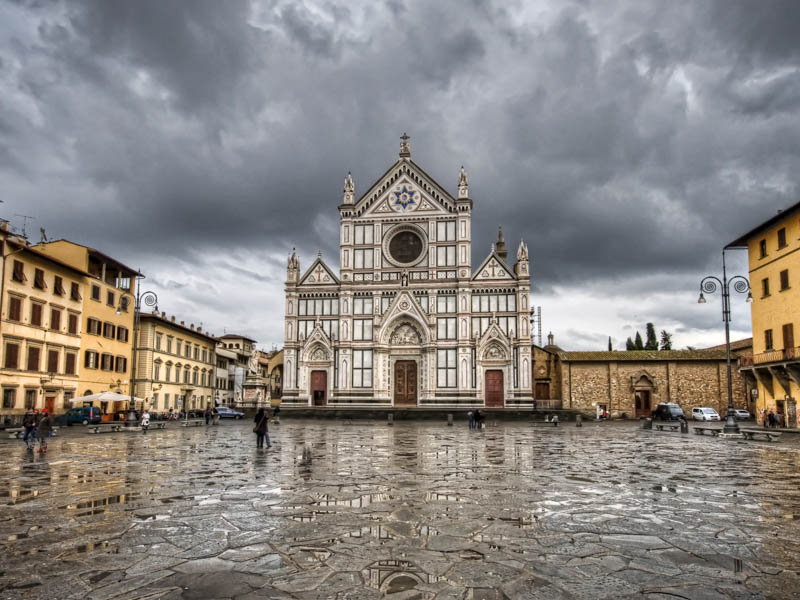
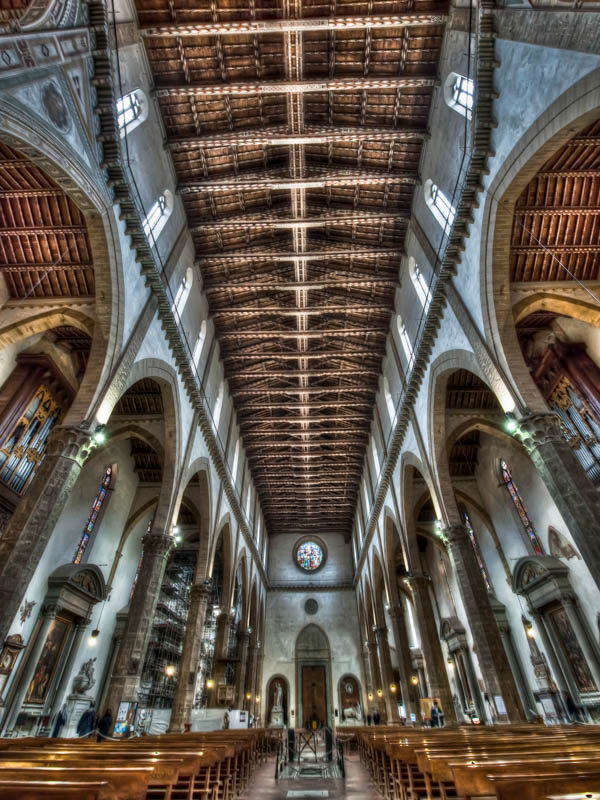
This big ol' barn of a Franciscan church on Florence's western edge is a shrine of great 14th-century frescoes by the likes of Giotto, the cloisters are home to Brunelleschi's Cappella de' Pazzi, the convent partially given over to a famous leather school, and the church itself serves as the Westminster Abbey of the Renaissance, scatterd with the (often monumental) tombs of such Florentine notabels as Michelangelo, Galileo, Machiavelli, and more.
Also like Westminster, Santa Croce now (scandalously) charges an admission fee.
The center of the Florentine Franciscan universe was begun in 1294 by Gothic master Arnolfo di Cambio in order to rival the huge church of Santa Maria Novella being raised by the Dominicans across the city.
The church wasn't completed and consecrated until 1442, and even then it remained faceless until the neo-Gothic facade was added in 1857 (and cleaned in 1998–99).
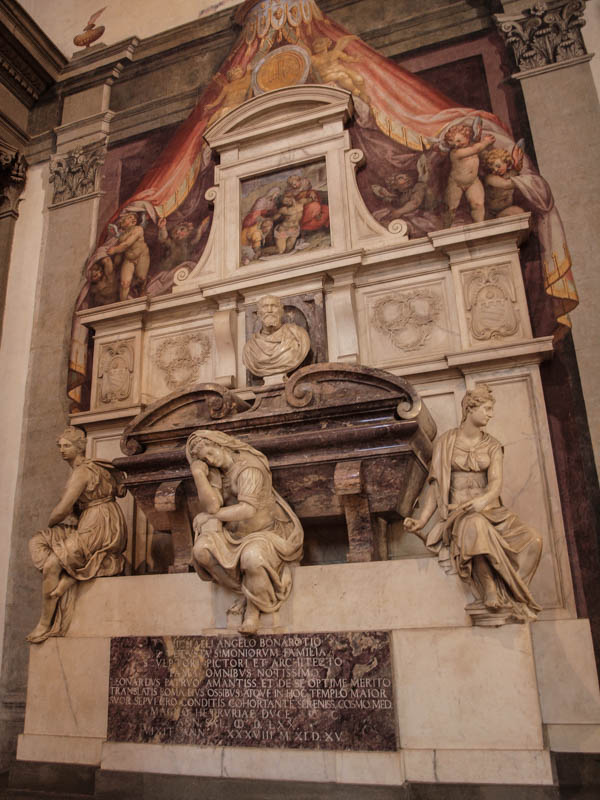
The Gothic interior is wide and gaping, with huge pointed stone arches creating the aisles and an echoing nave trussed with wood beams, in all feeling vaguely barnlike (an analogy the occasional fluttering pigeon only enforces).
The floor is paved with worn tombstones—because being buried in this hallowed sanctuary got you one step closer to Heaven, the richest families of the day paid big bucks to stake out small rectangles of the floor.
On the right aisle is the first tomb of note, a mad Vasari contraption containing the bones of the most venerated of Renaissance masters, Michelangelo Buonarroti, who died of a fever in Rome in 1564 at the ripe age of 89. The pope wanted him buried in the Eternal City, but Florentines managed to sneak his body back to Florence.
Past Michelangelo is a pompous 19th-century cenotaph to Florentine Dante Alighieri, one of history's greatest poets, whose Divine Comedy codified the Italian language. He died in 1321 in Ravenna after a long and bitter life in exile from his hometown (on trumped-up embezzlement charges), and that Adriatic city has never seen fit to return the bones to Florence, the city that would never readmit the poet when he was alive.
Against a nave pillar farther up is an elaborate pulpit (1472–76) carved by Benedetto di Maiano with scenes from the life of St. Francis.
Next comes a wall monument to Niccolò Machiavelli, the 16th-century Florentine statesman and author whose famous book The Prince was the perfect practical manual for a powerful Renaissance ruler and who has since gotten a bad rap (and even a adjective: "macchivallian") for just coming right out and telling the truth: That a good ruler sometimes has to be sneaky, even mean.
Past the next altar is an Annunciation (1433) carved in low relief of pietra serena and gilded by Donatello. (If you were wondering, Donatello is one notable artist not interred here; he is buried by his patrons, the Medici, in San Lorenzo.)
Nearby is Antonio Rossellino's 1446 tomb of the great humanist scholar and city chancellor Leonardo Bruni (d. 1444).
Beyond this architectural masterpiece of a tomb is a 19th-century knockoff honoring the remains of Gioacchino Rossini (1792–1868), composer of the Barber of Seville and the William Tell Overture, a.k.a. the Lone Ranger Theme).
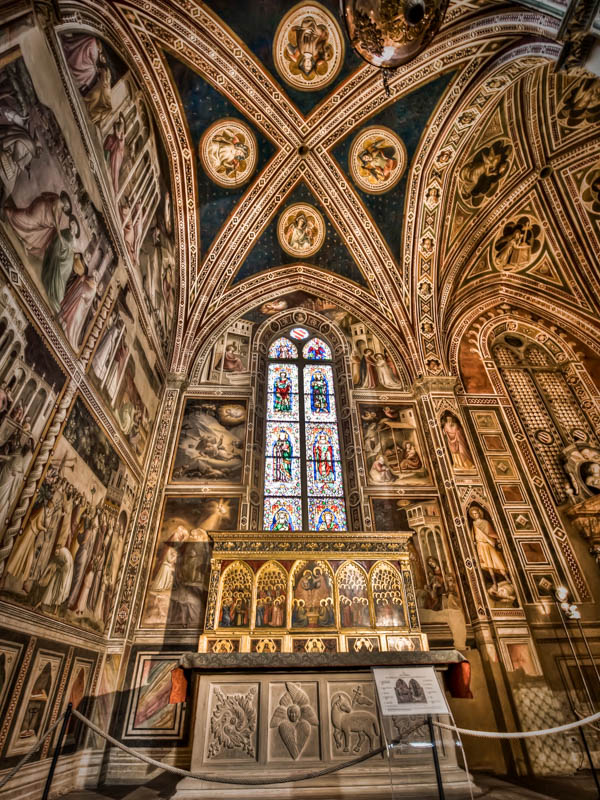
Around the corner in the right transept is the Cappella Castellani frescoed by Agnolo Gaddi and assistants, with a tabernacle by Mino da Fiesole and a Crucifix by Niccolò Gerini.
Agnolo's father, Taddo Gaddi, was one of Giotto's closest followers, and the senior Gaddi is the one who undertook painting the Cappella Baroncelli ★ (1332–38) at the transept's end. The frescoes depict scenes from the Life of the Virgin, and to the left of the window is an Angel Appearing to the Shepherds that constitutes the first night scene in Italian fresco.
Gaddi also designed the stained glass windows. The altarpiece Coronation of the Virgin is either by Gaddi himself, or perhaps even by his much more famous master, Giotto.
To the left of this chapel is a doorway, designed by Michelozzo, leading to the sagrestia (sacristy) past a huge Deposition (1560) by Alessandro Allori that had to be restored after it incurred massive water damage when the church was inundated during the 1966 flood.
Past the sacristy's gift shop is a famed leather school and store—a bit pricey, but of very high quality (www.scuoladelcuoio.com).
You can ask the workers to emboss your purchase—say, a wallet—with initials or a name in gold leaf. (Somewhere in a drawer, I still have a small leather change purse with my initials and the Lily of Florence in gold that I bought when I was 11.)
You can also enter the leather school at Via San Giuseppe 5r, around the left/north side of the church.
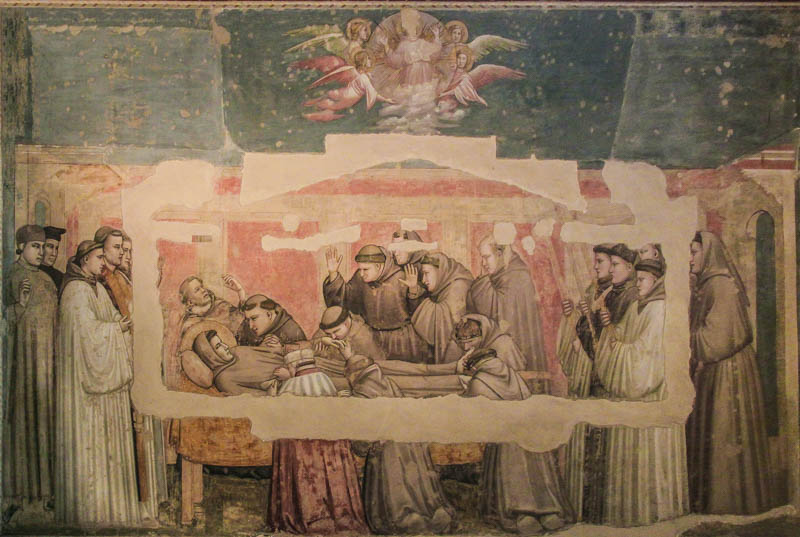
Back in the right transept, the two chapels to the right of the high altar were frescoed by the great Giotto, a former shepherd who became the forefather of the Renaissance in the early 14th century when he broke painting out of its static Byzantine mold and infused it with life, movement, depth, and emotion.
The Cappella Peruzzi ★★ on the right is a late work and not in the best shape. The many references to antiquity in the styling and architecture of the frescoes reflect Giotto's trip to Rome and its ruins. His assistant Taddeo Gaddi did the altarpiece.
Even more famous, if only as the setting for a scene in the film A Room with a View, is the Cappella Bardi ★★ immediately to the right of the high altar. The key panels here include the Trial by Fire Before the Sultan of Egypt on the right wall, full of telling subtlety in the expressions and poses of the figures.
One of Giotto's most well-known works is the lower panel on the left wall, the Death of St. Francis, where the monks weep and wail with convincing pathos, holding his hand tenderly and gazing despondently at their leader's dead face. Alas, big chunks of the scene are missing from when a tomb was stuck on top of it in the 17th century.
Yes, the yahoos of the baroque era whitewashed over the frescoes and rather rudly attched several wall tombs in their place.
To modern eyes, which view Giotto as one of the most important painters in the history of art, this act borders on artistic sacrilege—and much time and painstaking effort was spent (inexpertly) from 1841–52 to uncover and restore (inexpertly) the Giotto frescoes—but many baroque artists thought little of covering up what were, to them, crude medieval decorations.
(Taste is, of course, subjective, and I just hope our descendents don't develop a deep passion for the overwrought baroque era and become incensed that we destroyed the later decorations just to uncover a few ruined Giottos.)
Tip: Most people miss seeing Francis Receiving the Stigmata, which Giotto frescoed above the outside of the entrance arch to the chapel.
Agnolo Gaddi designed the stained-glass windows, painted the saints between them, and frescoed a Legend of the True Cross cycle on the walls of the rounded sanctuary behind the high altar.
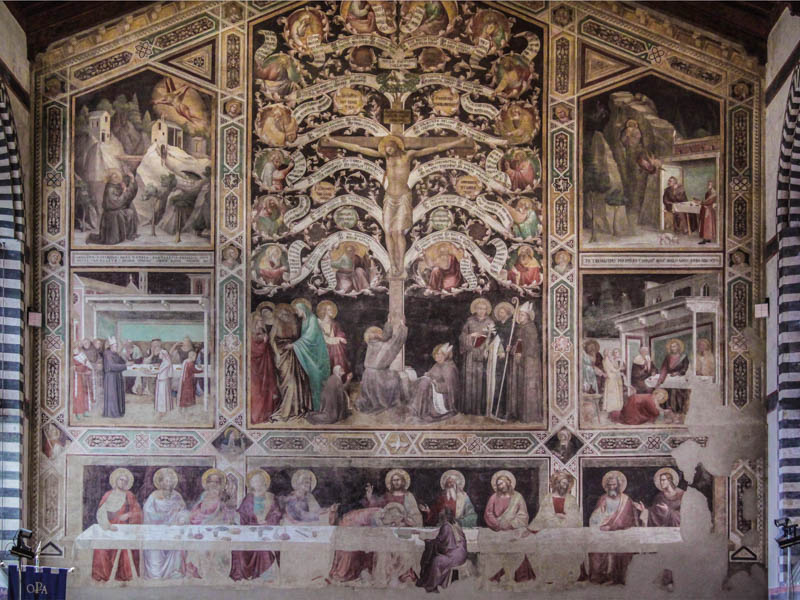
At the end of the left transept is another Cappella Bardi, this once housing a legendary Crucifix ★ by Donatello.
According to Vasari, Donatello excitedly called his friend Filippo Brunelleschi up to his studio to see this Crucifix when he had finished carving it.
The famed architect, whose tastes were aligned with the prevailing view of the time that refinement and grace were much more important than realism, criticized the work with the words, "Why Donatello, you've put a peasant on the cross!"
Donatello sniffed, "If it was as easy to make something as it is to criticize, my Christ would really look to you like Christ. So you get some wood and try to make one yourself."
Secretly, Brunelleschi did just that, and one day he invited Donatello to come over to his studio for lunch. Donatello arrived bearing the food gathered up in his apron.
Shocked when he beheld Brunelleschi's elegant Crucifix, he let the lunch drop to the floor, smashing the eggs, and after a few moments turned to Brunelleschi and humbly offered, "Your job is making Christs and mine is making peasants."
Tastes change, and to modern eyes this "peasant" stands as the stronger work. If you want to see how Brunelleschi fared with his Christ, visit it at Santa Maria Novella.
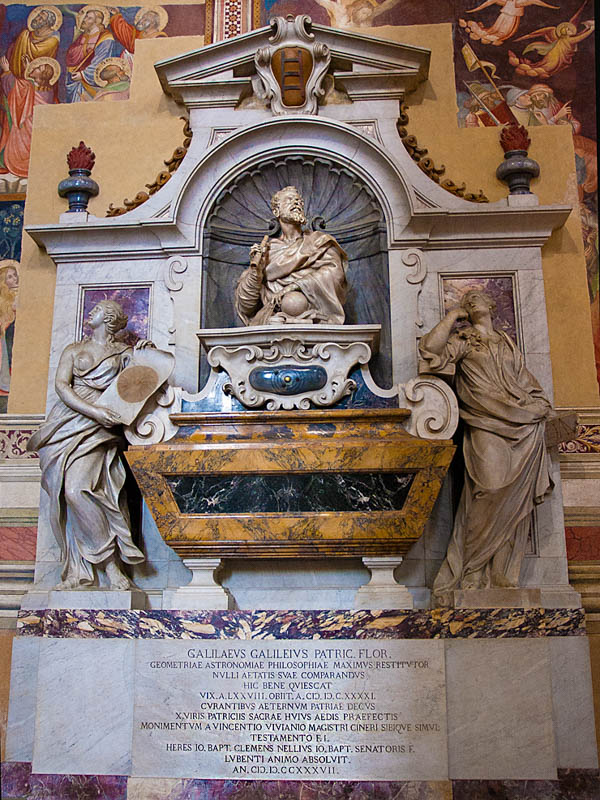
Past a door as you head back down the left aisle is a 16th-century Deposition by Bronzino.
A bit farther along, against a pier, is the roped-off floor tomb of Lorenzo Ghiberti, sculptor of the baptistery doors.
Against the wall is an altarpiece of the Incredulity of St. Thomas by Giorgio Vasari.
The last tomb on the right is that of Galileo Galilei (1564–1642), the preeminent Pisan scientist who figured out everything from the action of pendulums and the famous law of bodies falling at the same rate (regardless of weight) to discovering the moons of Jupiter and asserting that Earth revolved around the Sun.
This last one got him in trouble with the church, which tried him in the Inquisition and—when he wouldn't recant—excommunicated him.
At the urging of friends frightened his obstinacy would get him executed as a heretic, Galileo eventually kneeled in front of an altar and "admitted" he'd been wrong (though legend holds that, under his breath, he muttered "Eppur, si muove"—"And yet, it moves"—referring to the motion of the Earth around the sun.).
Galileolived out the rest of his days under house arrest in his villa near Florence and wasn't allowed a Christian burial until 1737.
Giulio Foggini designed this tomb for him, complete with a relief of the solar system—the sun, you'll notice, is properly at the center.
The pope finally got around to lifting Galileo's excommunication in 1992.
Italians still bring him fresh flowers.
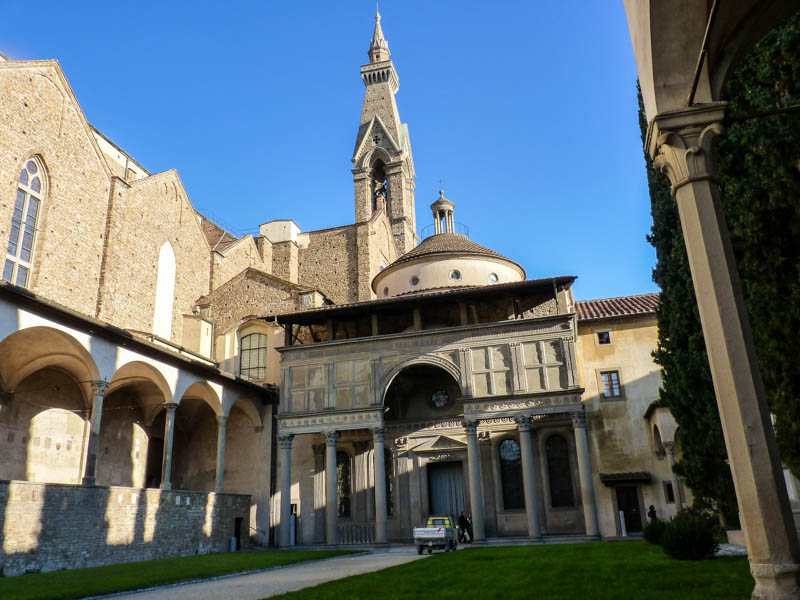
After you finish with the church itself, you wend your way through a series of pretty cloisters on the south flank containing modern sculptures and the Cappella de' Pazzi, or Pazzi Chapel ★,o =ne of Filippo Brunelleschi's architectural masterpieces (faithfully finished after his death in 1446).
Giuliano di Maiano probably designed the porch that now precedes the chapel, set with glazed terra cottas by Luca della Robbia. The rectangular chapel is one of Brunelleschi's signature pieces and a defining example of (and model for) early Renaissance architecture.
Light gray pietra serena is used to accent the architectural lines against smooth white plaster walls, and the only decorations are della Robbia roundels of the Apostles (1442–52). The chapel was barely finished by 1478, when the infamous Pazzi Conspiracy got the bulk of the family, who were funding this project, either killed or exiled.
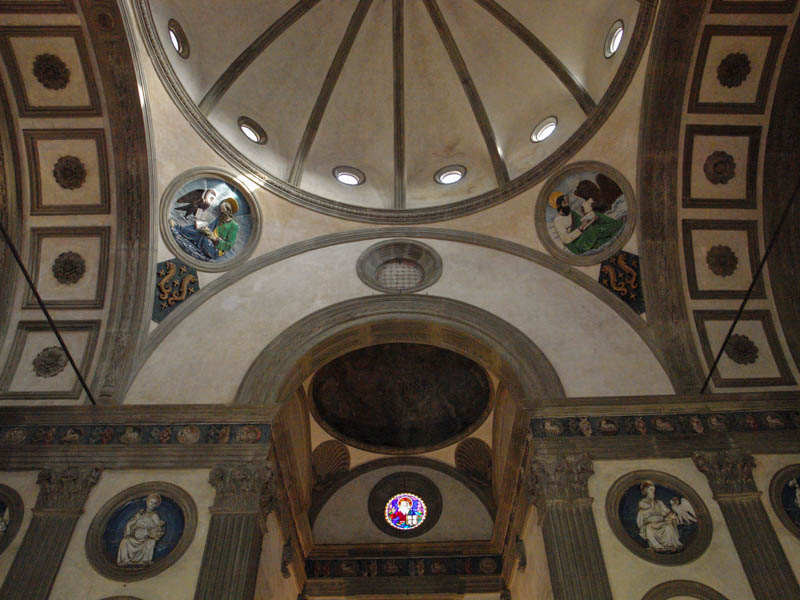
Also along these cloisters—planted with cypress and filled with bird song—parts of Santa Croce's convent have been set up as a museum, mainly to harbor artistic victims of the 1966 Arno flood, which buried the church under 20 feet of mud and water.
From back in the first cloister you can enter the museum proper via the long hall of the refectory. On your right as you enter is the painting that became emblematic of all the artworks damaged during the 1966 flood, Cimabue's Crucifix ★, one of the masterpieces of the artist who began bridging the gap between Byzantine tradition and Renaissance innovation, not the least by teaching Giotto to paint.
The ancient refectory was frescoed by Gothic great Taddeo Gaddi with a de rigueur Last Supper scene (conventual dining halls often had this most famous of biblical meals painted on one wall) just beneath a massive Tree of Life.
Also here are fresco fragments by Andrea Orcagna, which used to be on the right wall of the church itself; and Donatello's bronze St. Louis of Toulouse (in a plaster niche recreating its original housing on the exterior of the Orsanmichele.
Piazza Santa Croce 16 (though you now enter around the left side on Largo Bargellini)
tel. +39-055-246-6105 or 055-244-619
www.santacroceopera.it
www.operadisantacroce.it
Leather school: www.scuoladelcuoio.com
Mon–Sat 9:30am–5:30pm
Sun 2–5pm
€8
Tickets: City Dicovery
With Firenze Card: Free
Bus: C3, C1; 23; 13
Hop-on/hop-off: Santa Croce (A), Corso Tintori (C); Teatreo Verdi (A)
Planning your day: If you just pop around the church to see its sights, it'll take maybe 35 minutes.
Add in another 20–30 minutes to tour the adjacent museum, and at least 15 minutes for the leather school (more if you've come to shop and plan to pick over the goods).
The ticket office closes 30 minutes early.
Take a guided tour of Basilica di Santa Croce with one of our partners:
For €2.50 more, you can get a biglietto cumultivo that also gets in you into the nearby Casa Buonarotti, which houses some early works by Michelangelo
You can attend mass Sundays (and Holidays) at 9:30am, 11am, noon, and 6pm; Mon–Sat at 9am and 6pm. (In August: Mon–Sat 6pm; Sun 11am and noon)
Share this page
Search ReidsItaly.com
Piazza Santa Croce 16 (though you now enter around the left side on Largo Bargellini)
tel. +39-055-246-6105 or 055-244-619
www.santacroceopera.it
www.operadisantacroce.it
Leather school: www.scuoladelcuoio.com
Mon–Sat 9:30am–5:30pm
Sun 2–5pm
€8
Tickets: City Dicovery
With Firenze Card: Free
Bus: C3, C1; 23; 13
Hop-on/hop-off: Santa Croce (A), Corso Tintori (C); Teatreo Verdi (A)